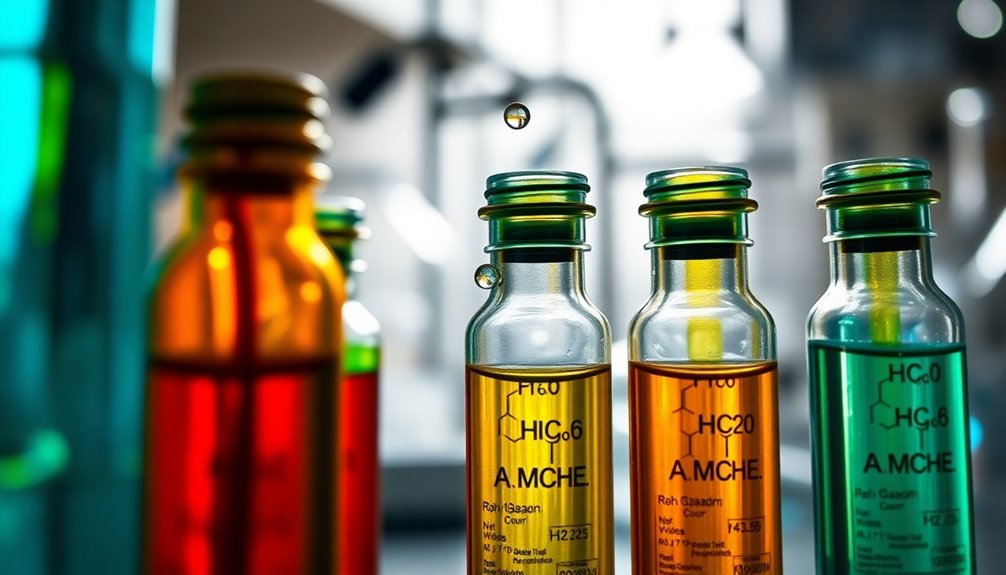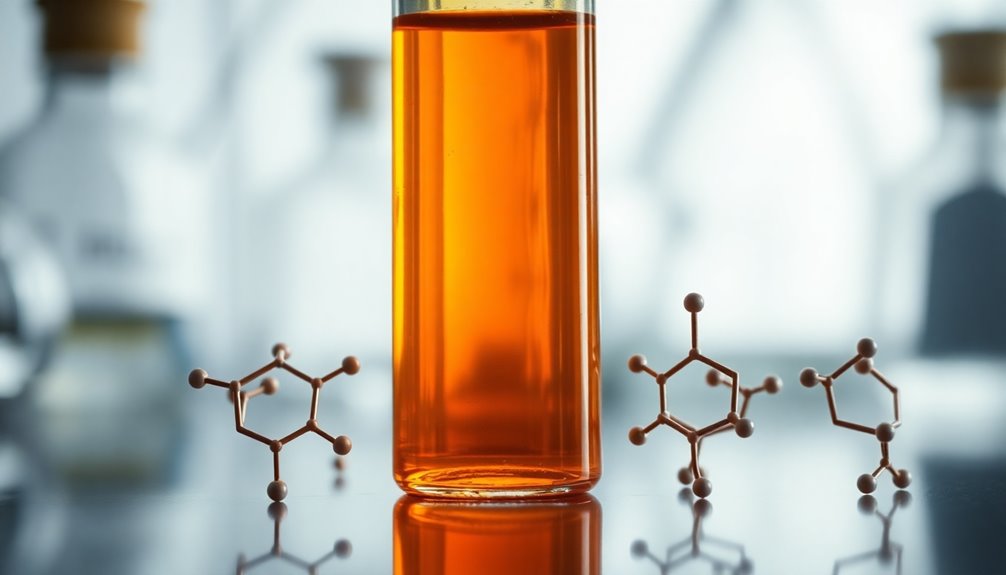Aromatic aldehydes don't give a positive Fehling test. This is because their stable structures make them less reactive than aliphatic aldehydes. In the Fehling test, copper(II) ions need a reactive aldehyde to reduce to copper(I) ions, forming a brick-red precipitate. Aromatic aldehydes, like benzaldehyde, lack the electron-donating groups that make aliphatic aldehydes more reactive. As a result, you won't see that characteristic red precipitate with aromatic aldehydes. If you're curious about other tests or details regarding these compounds, you might find the following information particularly enlightening.
Key Takeaways
- Aromatic aldehydes, such as benzaldehyde, do not react in Fehling's test.
- They lack sufficient reducing properties due to their stable carbonyl groups.
- The presence of an aromatic ring reduces their electrophilicity compared to aliphatic aldehydes.
- A positive Fehling's test indicates the presence of reducing sugars or aliphatic aldehydes.
- Analytical techniques like DNPH can be used to characterize aromatic aldehydes instead.
Overview of Fehling's Test

Fehling's test is a straightforward chemical procedure that helps you identify reducing sugars and certain aldehydes. This test employs two solutions: Fehling's A, which contains copper sulfate, and Fehling's B, an alkaline solution of sodium potassium tartrate.
When you mix these solutions and introduce an aldehyde, a brick-red precipitate of copper(I) oxide forms, indicating a positive reaction.
However, keep in mind that aromatic aldehydes, like benzaldehyde, typically don't react, resulting in a negative test. This happens because their aromatic structures inhibit the reduction of copper(II) ions.
Consequently, while the Fehling test is effective for aliphatic aldehydes, it's less reliable for distinguishing aromatic aldehydes due to their non-reducing properties.
Mechanism of Fehling's Reaction

In understanding the mechanism of Fehling's reaction, you'll see how copper(II) ions are reduced to copper(I) oxide by aldehydes, producing that telltale brick-red precipitate.
The reactivity of the aldehyde plays an essential role here; electron-donating groups enhance this reduction process.
However, keep in mind that aromatic aldehydes, like benzaldehyde, typically don't participate due to their weaker reducing properties.
Copper Ion Reduction
When examining the mechanism of copper ion reduction in Fehling's reaction, you'll find that it primarily involves the conversion of copper(II) ions (Cu²⁺) to copper(I) ions (Cu⁺).
This reaction occurs when a suitable reducing agent, like an aldehyde, is present. In the case of aliphatic aldehydes, this reduction leads to the formation of a red-brown precipitate of copper(I) oxide (Cu₂O), indicating a positive Fehling's test.
However, aromatic aldehydes, such as benzaldehyde, don't effectively reduce Cu²⁺ ions due to their stabilized carbonyl groups. The presence of conjugated double bonds in these compounds hampers their reactivity, resulting in a negative test.
Consequently, aromatic aldehydes are less capable of participating in the copper ion reduction required for a positive result.
Aldehyde Reactivity Factors
Aldehyde reactivity plays an essential role in determining the outcome of Fehling's test. Aromatic aldehydes typically show a negative result because their stable conjugated pi electron systems hinder oxidation.
Here are some key factors influencing aldehyde reactivity:
- Structural Features: Aromatic aldehydes lack electron-donating substituents.
- Conjugated Systems: These systems reduce electron density, limiting their ability to reduce copper ions.
- Oxidation Potential: Aliphatic aldehydes readily oxidize, forming red precipitates.
- Copper Ion Interaction: Aromatic aldehydes don't effectively facilitate copper(II) ion reduction.
- Reaction Mechanism: The reduction of Cu²⁺ to Cu₂O requires reactive aldehydes, which aromatic types aren't.
Understanding these factors explains why aromatic aldehydes generally don't react positively in Fehling's test.
Characteristics of Aromatic Aldehydes
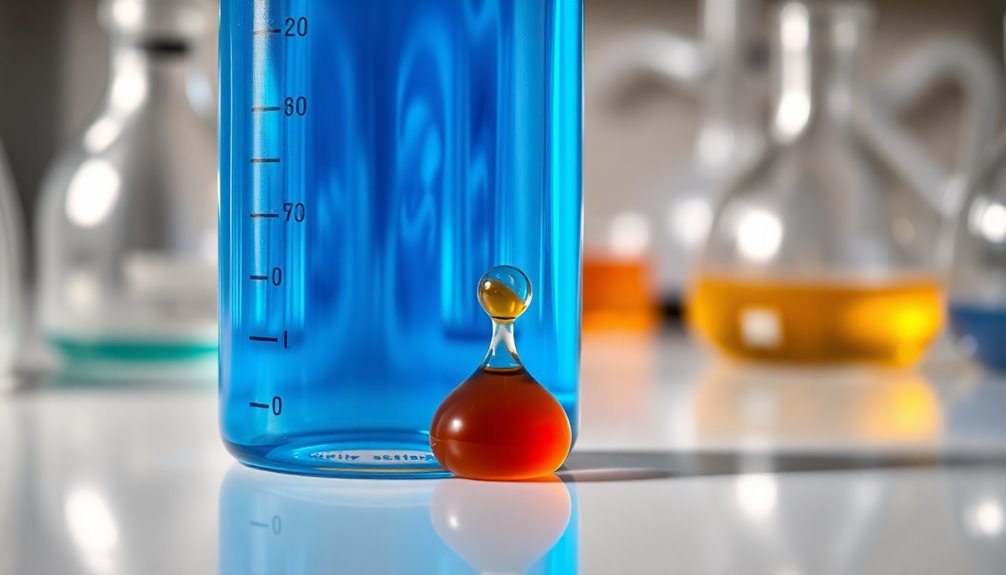
When you look at aromatic aldehydes, you'll notice their unique chemical structure and properties, like the stability of the carbonyl group due to the conjugated π-electron system.
Unlike aliphatic aldehydes, they won't react with Fehling's solution, highlighting their non-reducing nature.
This distinction is essential for understanding their behavior in organic chemistry and how they differ from aliphatic counterparts.
Chemical Structure and Properties
Although aromatic aldehydes, like benzaldehyde, share the common functional group characteristic of aldehydes, their unique chemical structure greatly influences their properties.
The presence of a carbonyl group in these compounds creates distinct characteristics that affect their reactivity.
- The conjugated pi electron system stabilizes the molecule.
- Aromatic aldehydes have a less electrophilic carbonyl group compared to aliphatic aldehydes.
- They typically don't reduce copper(II) ions in Fehling's test.
- Their structural stability inhibits the oxidation reaction needed for a positive test.
Understanding these features helps predict their behavior in various chemical tests.
Recognizing these aspects is essential for grasping why aromatic aldehydes don't react as expected in tests like Fehling's.
Reactivity With Fehling's Solution
While exploring the reactivity of aromatic aldehydes with Fehling's solution, you'll find that compounds like benzaldehyde don't participate in the reaction.
This lack of reactivity stems from the stability provided by their conjugated pi electron system, which prevents them from effectively reducing copper(II) ions. As a result, aromatic aldehydes yield a negative result in Fehling's test, classifying them as non-reducing compounds.
In contrast, aliphatic aldehydes readily reduce Fehling's solution, producing a red precipitate of copper(I) oxide.
Understanding this distinction is vital for accurately identifying carbonyl compounds in organic chemistry.
#
Comparison With Aliphatic Aldehydes
Aromatic aldehydes differ significantly from their aliphatic counterparts in both structure and reactivity. While aliphatic aldehydes like formaldehyde and acetaldehyde readily reduce Fehling's solution, producing a red precipitate, aromatic aldehydes such as benzaldehyde fail to do so.
Here are some key differences:
- Aromatic aldehydes have a stable conjugated system.
- They lack the necessary reducing properties for Fehling's test.
- Aliphatic aldehydes easily donate electrons.
- Steric hindrance in aromatic aldehydes limits their reactivity.
- Aromatic aldehydes are generally resistant to oxidation under mild conditions.
These differences highlight why aromatic aldehydes don't produce the same results as aliphatic aldehydes in the Fehling's test, showcasing their unique chemical behavior.
Why Aromatic Aldehydes Fail the Test

When you conduct Fehling's test, you'll notice that aromatic aldehydes, like benzaldehyde, don't produce any color change.
This lack of reaction arises because the stability of the aromatic ring prevents oxidation. The conjugated pi electron system in these compounds makes them less reactive towards oxidizing agents present in Fehling's test.
Fundamentally, aromatic aldehydes lack the necessary electron-donating groups that are vital for reduction to take place. The test relies on reducing copper(II) ions to copper(I) oxide, a process that aromatic aldehydes simply don't facilitate due to their resistance to oxidation.
Consequently, while you might see a positive result with aliphatic aldehydes, aromatic aldehydes remain unreactive, leading to no discernible color change.
## Comparison With Aliphatic Aldehydes
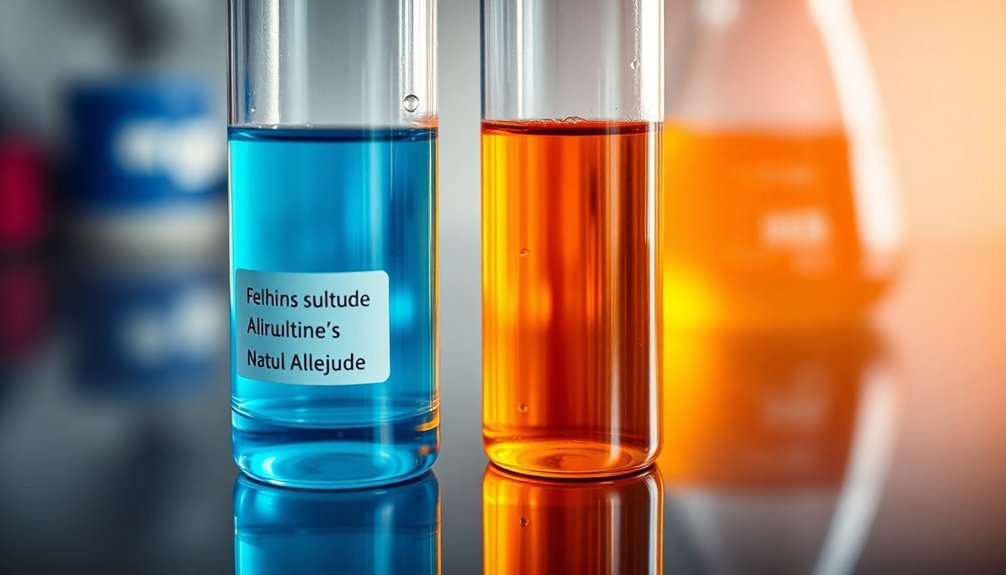
The differences in reactivity between aromatic and aliphatic aldehydes become evident when you compare their behavior in Fehling's test.
Aromatic aldehydes, like benzaldehyde, don't show a positive result, while aliphatic aldehydes, such as formaldehyde and acetaldehyde, do.
Here are some key points to take into account:
- Aromatic aldehydes lack reducing properties.
- Aliphatic aldehydes readily reduce copper(II) ions.
- Conjugated systems in aromatic aldehydes stabilize them.
- Aliphatic aldehydes are more reactive due to less resonance stabilization.
- Understanding these differences is essential for accurate Fehling's test results.
Other Tests for Aromatic Compounds

While Fehling's test fails to identify aromatic aldehydes, several alternative methods can effectively reveal their presence.
One of the most reliable tests used is the Tollens' test, which detects aromatic aldehydes by reducing silver ions to form a characteristic silver mirror. This reaction exploits the unique properties of aromatic compounds, allowing for clear identification.
Additionally, you can use 2,4-dinitrophenylhydrazine (DNPH), which forms hydrazones upon reaction with aromatic aldehydes. These hydrazones can be further characterized by examining their melting points or employing various spectroscopic techniques.
Implications in Organic Chemistry
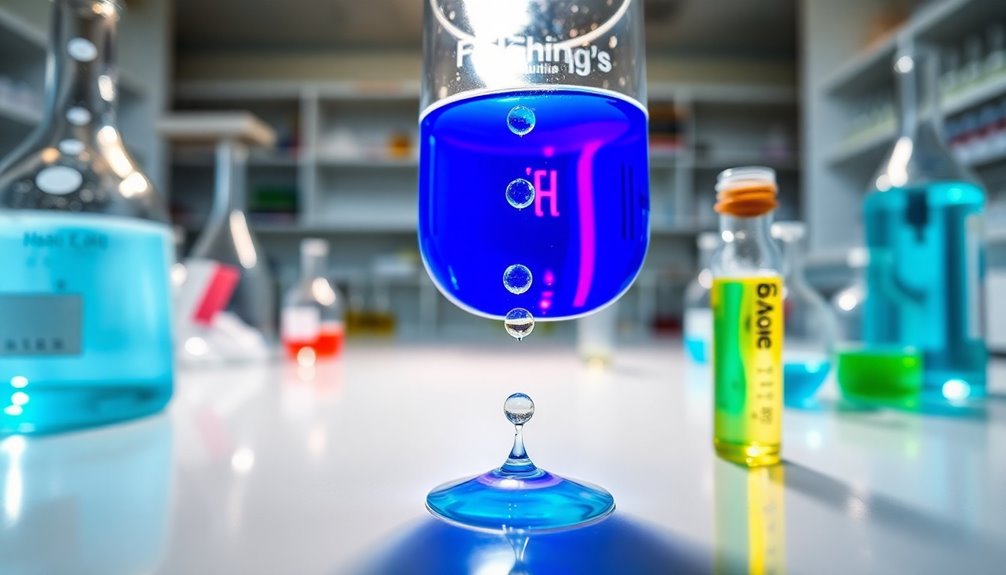
Understanding the behavior of aromatic aldehydes in tests like Fehling's not only clarifies their unique properties but also highlights their significance in organic chemistry.
Since aromatic aldehydes generally don't give a positive Fehling's test, this distinction is essential for identifying functional groups.
Here are some implications to take into account:
- Aromatic aldehydes resist reducing copper(II) ions in Fehling's test.
- The stability of the aromatic ring decreases reactivity at the carbonyl carbon.
- Positive Fehling's results indicate non-aromatic aldehydes.
- This knowledge helps predict reactivity in synthetic pathways.
- Fehling's test differentiates between reducing and non-reducing sugars and aldehydes.
Summary of Key Points

When analyzing the behavior of aromatic aldehydes in Fehling's test, you'll notice that they typically don't react, leading to a negative result. This lack of reaction is due to the stability of the aromatic ring, which prevents the aldehyde from acting as a reducing agent.
In contrast, Fehling's test is effective for identifying aliphatic aldehydes, which can easily reduce copper(II) ions to produce a brick-red precipitate. For instance, common aromatic aldehydes like benzaldehyde fail to yield this characteristic result.
Understanding the differences in reactivity between aromatic and aliphatic aldehydes is essential for accurately interpreting Fehling's test outcomes in organic chemistry. Recognizing these distinctions enhances your grasp of aldehyde behavior in chemical reactions.
Frequently Asked Questions
Why Don't Aromatic Aldehydes Give Fehling's Test?
Aromatic aldehydes don't give Fehling's test because their stable aromatic structure lacks the necessary reducing properties.
You'll notice that the conjugated pi electron system stabilizes the carbonyl group, making it less reactive toward oxidation.
Unlike aliphatic aldehydes, which can easily reduce copper(II) ions, aromatic aldehydes can't donate electrons effectively.
The electron-withdrawing nature of the aromatic ring further inhibits their reactivity, preventing a positive result in the test.
Which Aldehydes Do Not Give Fehling's Test?
Picture a dance party where only certain dancers can shine under the spotlight. Just like that, some aldehydes don't perform in Fehling's test.
Aromatic aldehydes, like benzaldehyde and cinnamaldehyde, skip the show because they lack reducing properties. They stand out in a crowd, but not for the right reasons.
In contrast, aliphatic aldehydes take center stage, readily reacting and giving that vibrant color change you're looking for.
Do Aromatic Aldehydes Give Tollens Test?
Aromatic aldehydes, like benzaldehyde, don't give a positive Tollens test.
You're likely to see a silver mirror with reactive aldehydes, but aromatic ones resist oxidation under mild conditions. This means they won't react with the Tollens reagent.
In contrast, aliphatic aldehydes, such as formaldehyde, readily produce that silver mirror.
Do Aromatic Aldehydes Give Schiff's Test?
Think of aromatic aldehydes like a locked treasure chest; their reactivity is hidden away. When you try Schiff's test, expecting a vibrant pink, you find nothing but silence.
That's because the electron-withdrawing aromatic ring keeps them from reacting with Schiff's reagent. Unlike their aliphatic cousins, they don't reveal their secrets easily, leaving you with a negative result.
Conclusion
In the colorful world of organic chemistry, aromatic aldehydes might seem like alluring jewels, but they don't respond to Fehling's test like their aliphatic counterparts. Picture a vibrant blue solution that remains unchanged, reflecting the stability of aromatic structures. While they hold their secrets tightly, other tests await to reveal their identities. So, as you navigate this landscape, remember that not all compounds shine under the same light, but each has its own story to tell.



